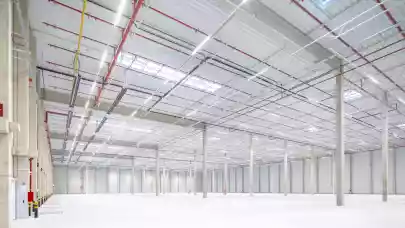A fear of rising vacancies caused by overdevelopment has long been in the centre of news regarding the Warsaw office market. Ewelina Kauzna MRICS, Director of the Office Agency, Landlord Representation at Colliers International in Poland talked to us about what is happening in the capital and in other Polish cities.
A fear of rising vacancies caused by overdevelopment has long been in the centre of news regarding the Warsaw office market. Ewelina Kauzna MRICS, Director of the Office Agency, Landlord Representation at Colliers International in Poland talked to us about what is happening in the capital and in other Polish cities.
Even though the Polish market is the most attractive and most popular one in CEE, vacancy rates are rising and there are a lot of voices saying that it is getting overheated. What is your opinion?
The first thing that distinguishes Poland from other CEE countries is that our market is not limited to the capital only. Of course, Warsaw is the biggest office market in Poland with significant stock of space, but there are also many secondary cities growing dynamically mostly thanks to the BPO and SSC centres that are coming to the country. The market is competitive because developers are very active in Poland nowadays, but the good ones will fill their offices successfully. What is more, from the beginning of 2015, the Warsaw market was characterised by a high level of tenant activity, which is confirmed by the transaction volume, which is already higher than in the entire 2014 and amounted to 608 000 square metres in Q1-Q3 2015.

Do you expect a consolidation on the market in terms of developments?
We have seen a consolidation on the tenant side in Warsaw for some time already. The big players like banks, financial institutions and insurance companies are merging not only on operational level but also in terms of office space.
Does it also mean less office space required from their side?
They need less office space, but they need a few thousand square meters in a single project, which is perfect for big developers willing to start construction. They can fulfil banks’ requirements regarding the pre-lease rate. For example letting smaller space in five buildings would not be so attractive in terms of securing financing.
In terms of BPOs and SSCs, is it more the secondary cities attracting these tenants or is it also Warsaw?
Warsaw is usually not mentioned when talking about BPO and SSC In Cracow companies from these sectors account for more than 70% of the market (vs approx. 18% in Warsaw) while in Warsaw companies place their headquarters mainly. In terms of square meters, however, Warsaw is a big market and now that rents went down it is becoming more attractive despite higher labour costs. The thing with BPO and SSC companies, however, is that developers cannot use them to fulfil the pre-lease requirements because usually if they decide to open an office in a new city they need offices right away. That is why developers in secondary cities need to construct quicker than the tenants' needs arise.
When you talk to potential tenants, do you feel that they are choosing between Poland, Slovakia, the Czech Republic, and Hungary?
We can say that this is a competition between CEE countries. First they choose the country, and then they choose the city, so there is a competition between the cities within one country as well.
In your experience what are the most important factors that are driving their decisions when it comes to choosing countries?
Labour costs and availability of office space are the key aspects. However, political stability, subsidies and tax reliefs are also taken into account.
Is the level of rents an important factor?
Yes, it is because the costs are very important for this kind of operation. In case of headquarter offices rental costs account for 5 - 10% of the total costs only, but for the BPO and SSC sector it is different because they can only work well if the costs are lower than in other countries.
How much more expensive is Warsaw compared to secondary cities in terms of rents?
It depends on the location within the city. Currently, you can find similar prices in some districts of Warsaw as in Wroclaw and Cracow which is why Warsaw is becoming more and more attractive and the higher labour costs are balanced in some way.
Do you expect vacancy rates in Warsaw to increase over the next year?
New projects being delivered to the Warsaw market are not struggling so much with vacancy as tenants want to move into these buildings. However, older projects -even 5 years old - are starting to have more problems with the rising vacancy. The key issue is to find an effective way to recommercialize these projects as the needs of the tenants are changing. They are not only looking at technical details anymore; they are looking for something that will differentiate the building because they are often struggling to attract good employees. This is something that could keep the employees and bring in new ones. Generations are changing and they need more than just an office. I think the winners will be the owners with an idea on how to tailor their building to the evolving needs of tenants.
I was wondering if you have the same trend as in Budapest. 10-15 years ago a lot of companies which tended to be cool in the eyes of the employees moved outside or to the outskirts of the city into office parks. But now the trend has reversed and these companies are moving right into the city centre because most of their young employees like to live there and don't own a car. Is it the same thing in Warsaw?
We do not observe such a trend, but the structure of the city is different and we have quite a lot of new office hubs which are very close to the city centre with the new metro line nearby. The key is to have good transportation, especially the metro connection. As you said, the younger generation prefers public transport and bikes over cars, so it is important to have that kind of infrastructure and the time to get to the office is also a major factor.

You said that tenant requirements are changing. Do you see a trend of people working from home instead of the office or spending only a part of their time at the office?
A few years ago we had a huge discussion in Colliers about what to expect in the future, whether younger generations will be still interested in working in an office. We thought that they would be more interested to work remotely, but after a few years the surveys showed that employees want to work with others and in teams. However, people need different offices than in the past: more social areas, meeting rooms etc. Companies used to have meeting rooms for clients only; now at Colliers we have 16 internal meeting rooms for our employees. Perhaps for the next generation we will once again have to change the way we are working, but today we can definitely see the need to have an office.



